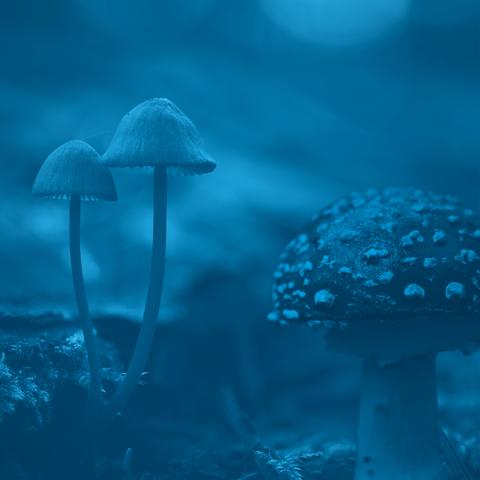The ability of psychotropic mushrooms to bring about states of consciousness comparable to mystical experiences has been known for centuries, possibly millennia. They have been used as a sacrament in structured religious ceremonies and are still used for recreational purposes in the Western world [1,2]. Although psilocybin-containing mushrooms (“magic mushrooms”) are by far the most renowned and most potent, there are other psychoactive mushrooms. One of these is Amanita muscaria or the fly amanita/agaric mushroom. However, the primary active ingredient in this mushroom is agarin (or muscimol) instead of psilocybin.
Psychotropic mushrooms are distributed throughout the world and mostly belong to saprotrophic, but also ectomycorrhizal (symbiotic) genera: Psilocybe, Panaeolus including Copelandia, Pluteus, Gymnopilus, Pholiotina, Galerina, and Inocybe [1].
Interest in psilocybin-containing mushrooms is growing in the United States, with 12.3% of adults reporting using them in 2022, up significantly from 11.4% in 2021 [3]. Psilocybin-containing mushrooms are therefore the most commonly used hallucinogenic substance. This growing interest has also sparked a new commercial market for other types of mushrooms such as the fly amanita.
Given this increasing public interest, this article aims to provide information about each of these compounds and comment on their similarities and differences, their effects, and the implications associated with their use.
Psilocybin
Psilocybin, alongside its active metabolite psilocin, are the two main hallucinogenic compounds of “magic mushrooms” [4,5] and are listed as Schedule I drugs under the United Nations 1971 Convention on Psychotropic Substances [1]. They are controlled substances in many countries and have been illegal in many jurisdictions since the 1960s and 1970s. As of 2022, psilocybin-containing fungi were allowed to be consumed in Brazil, Jamaica, and the Netherlands. Compared with other legal and illegal drugs, these mushrooms have been stated to represent a much lower risk to users and society [6,7].
Psilocybin is a serotonergic drug because it shares a common mechanism of action with serotonin, consisting of agonism in different serotonergic receptors, particularly the 5-HT2A receptors [8]. Serotonergic drugs produce profound modifications in perceptions and cognition. During the last few years, psilocybin and psilocin have gained therapeutic relevance, but considerable physiological variability between individuals can influence dose-response and toxicological profile has been reported. Psilocybin is mainly a pro-drug that is dephosphorylated by alkaline phosphatase to its active metabolite psilocin. This is then further metabolized, producing psilocin-O-glucuronide as the main urinary metabolite [4].
There are promising results that suggest psilocybin could be beneficial in psychedelic therapy for the treatment of depression, addiction, post-traumatic stress, or mental disorders [1].
Agarin
The fly amanita (Amanita muscaria) mushrooms contain agarin (or muscimol) and its biosynthetic precursor ibotenic acid. Agarin is psychotropic whereas ibotenic acid is not. Both compounds can be fatal at a high enough dose [9,10]. However, unlike psilocybin-containing mushrooms, neither Amanita muscaria, agarin, or ibotenic acid are scheduled under the 1970 U.S. Controlled Substances Act or comparable international laws in most countries [3]. Some evidence even suggests that agarin may hold therapeutic potential based on pre-clinical studies.
Agarin is a colorless crystalline substance that is readily soluble in water but not in alcohol or organic solvents. It has been used extensively as a ligand to probe gamma-aminobutyric acid (GABA) receptors and assist in the development of GABAergic agents [11]. Whereas psilocybin acts on serotonergic receptors, agarin targets GABA receptors [12] as a selective agonist and works as a conformationally restricted derivative of GABA.
As with GABA, agarin is an inhibitor of central nervous system neurotransmission and has been shown to have a slow reaction time in a dose-dependent manner when microinjections of it were administered to animals [13]. It has also shown promise as an anticonvulsant [14], and an anticancer compound [15]. Recently, agarin modulation of GABA-A receptors was shown to reduce Aβ-induced neurotoxicity, lending support for future use against neurodegenerative conditions such as Alzheimer’s Disease [16].
Agarin has dose-dependent effects with higher doses leading to significant, albeit reversible, central nervous system symptoms. In controlled environments, its toxicity seems to be low, with no long-term lasting damage seen in animal studies, and human cases resolving without severe outcomes. Caution is nonetheless advised with its use due to its potent effects on the central nervous system.
One explanation for the growing interest in Amanita muscaria is its potential conflation with emerging clinical research emphasizing the safety and efficacy of psilocybin as an adjunct to psychotherapy in the treatment of depression. Beginning around 2010, a new era of clinical interest in psilocybin and other “classical psychedelics” emerged, which has been referred to as the “psychedelic renaissance.” During this time, the U.S. Food and Drug Administration (FDA) granted psilocybin breakthrough therapy designations for treatment-resistant depression in 2018 and major depressive disorder in 2019, and two U.S. states (Colorado and Oregon) have legalized psilocybin-assisted psychotherapy programs despite its Schedule I classification under the U.S. Controlled Substance Act [3].
Summary
Here, we have presented information on the similarities and differences between agarin and psilocybin in terms of mechanisms, effects, safety, and legality. There are distinct differences between them regarding the pathways acted upon in the central nervous system. There are also prominent differences in the legality of each substance, despite their emerging therapeutic relevance. The suitability of each substance for human use, dosage, and safety protocols are uniquely different concerning the data available from quality studies. Although mycotherapy offers promise for the scientific community and society at large, there are substantial hurdles that still need to be negotiated.
If you're interested in giving agarin a try, then check out Tro Zzz, our buccal troche formulated for sleep. It harnesses the combined power of science, nature, and your GABA system to help you achieve the sleep you've been longing for!
References
[1] K. Gotvaldová, J. Borovička, K. Hájková, P. Cihlářová, A. Rockefeller, M. Kuchař, Extensive Collection of Psychotropic Mushrooms with Determination of Their Tryptamine Alkaloids, Int J Mol Sci 23 (2022) 14068. https://doi.org/10.3390/ijms232214068.
[3] E.C. Leas, N. Satybaldiyeva, W. Kepner, K.H. Yang, R.M. Harati, J. Corroon, M. Rouffet, Need for a Public Health Response to the Unregulated Sales of Amanita muscaria Mushrooms, Am J Prev Med 67 (2024) 458–463. https://doi.org/10.1016/j.amepre.2024.05.006.
[5] J. Thomann, K.E. Kolaczynska, O.V. Stoeckmann, D. Rudin, P. Vizeli, M.C. Hoener, C.R. Pryce, F.X. Vollenweider, M.E. Liechti, U. Duthaler, In vitro and in vivo metabolism of psilocybin’s active metabolite psilocin, Front Pharmacol 15 (2024) 1391689. https://doi.org/10.3389/fphar.2024.1391689.
[7] R.T. Brown, C.R. Nicholas, N.V. Cozzi, M.C. Gassman, K.M. Cooper, D. Muller, C.D. Thomas, S.J. Hetzel, K.M. Henriquez, A.S. Ribaudo, P.R. Hutson, Pharmacokinetics of Escalating Doses of Oral Psilocybin in Healthy Adults, Clin Pharmacokinet 56 (2017) 1543–1554. https://doi.org/10.1007/s40262-017-0540-6.
[8] M.K. Madsen, P.M. Fisher, D. Burmester, A. Dyssegaard, D.S. Stenbæk, S. Kristiansen, S.S. Johansen, S. Lehel, K. Linnet, C. Svarer, D. Erritzoe, B. Ozenne, G.M. Knudsen, Psychedelic effects of psilocybin correlate with serotonin 2A receptor occupancy and plasma psilocin levels, Neuropsychopharmacology 44 (2019) 1328–1334. https://doi.org/10.1038/s41386-019-0324-9.
[9] E.M. Meisel, B. Morgan, M. Schwartz, Z. Kazzi, H. Cetin, A. Sahin, Two Cases of Severe Amanita Muscaria Poisoning Including a Fatality, Wilderness Environ Med 33 (2022) 412–416. https://doi.org/10.1016/j.wem.2022.06.002.
[10] M.J. Moss, R.G. Hendrickson, Toxicity of muscimol and ibotenic acid containing mushrooms reported to a regional poison control center from 2002-2016, Clin Toxicol (Phila) 57 (2019) 99–103. https://doi.org/10.1080/15563650.2018.1497169.
[13] A. Schmied, M. Amalric, J.F. Dormont, D. Farin, GABAergic mechanisms in the cat red nucleus: effects of intracerebral microinjections of muscimol or bicuculline on a conditioned motor task, Exp Brain Res 81 (1990) 523–532. https://doi.org/10.1007/BF02423501.
[15] M. Tatsuta, H. Iishi, M. Baba, H. Uehara, A. Nakaizumi, H. Taniguchi, Protection by muscimol against gastric carcinogenesis induced by N-methyl-N’-nitro-N-nitrosoguanidine in spontaneously hypertensive rats, Int J Cancer 52 (1992) 924–927. https://doi.org/10.1002/ijc.2910520616.






Comments (0)
There are no comments for this article. Be the first one to leave a message!